PARTICLE PHYSICS: Detecting Systems And Techniques For Finding Subatomic Particles
The most common techniques for finding the mass
and charge of a particle of matter are based on the following: a charged particle
moving at right angles to the direction of a magnetic field B experiences a
force which acts perpendicularly to its direction of motion and the direction
of the magnetic field. Remember that a force that acts at right angles to the
direction of motion of a body makes it move in a circular path.
The radius r of the circle can be used to calculate the charge to mass ratio Q/m of the particle – provided its speed v is known:
Q/m = v/Br
Or
r = p/BQ, where p is the momentum of the particle.
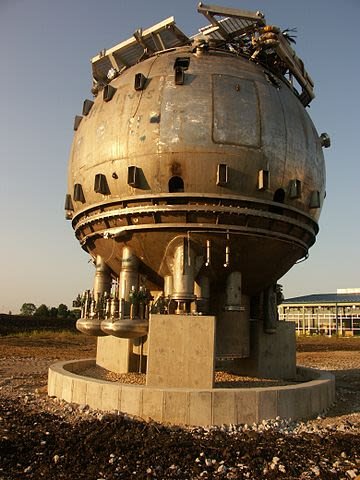
The figure below shows the paths made by many particles as they move through a detecting device, in this case, a bubble chamber. The paths are curved, and partícles carrying opposite charge curve in opposite directions – one clockwise, the other anticlockwise. Nowadays, in large physics laboratories, interpreting the images is done by computers. The tracks of the particles are detected electrically and the data fed directly into the computer. No human eye actually sees the particle tracks, let alone the particles.
EARLY PARTICLE DETECTORS
The cloud chamber was one of the earliest detectors. You may have one at school or college. Another cheap detector is the simple photographic plate. These were used a great deal in the 1940s and 1950s to investigate the cheapest source of unusual or fast-moving particles – cosmic rays. An array of the Geiger-Müller detectors can track the path of a particle in three dimensions, and the same principle is used in the most modern detector system, the multiwire array described below.
MODERN PARTICLE DETECTORS
The bubble chamber: Bubble chamber is the main tool for particle studies in the 1950s and 1960s, is a tank filled with ‘superheated’ fluid hydrogen. The liquid hydrogen is under pressure to keep it just on the point of boiling without actually doing so. When the pressure is slightly reduced, bubbles may form – think of opening a can of fizzy drink. But the bubbles need something to trigger them, just like the water drops in a cloud chamber. Any particle moving through the liquid creates ions, around which tiny bubbles form and show the particle’s path. The tank is in a strong magnetic field, so the charged particles follow curved paths as shown in the paths of particles in a bubble chamber.
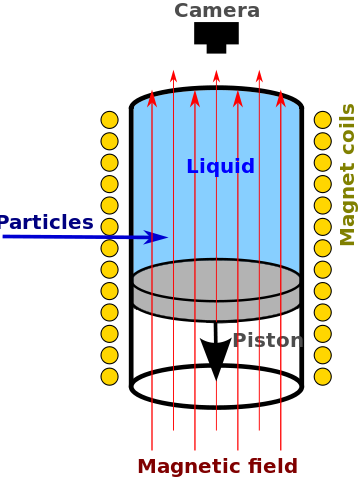
The drawback of the bubble chamber is that it only produces a bubble track when the pressure on the liquid is slightly reduced. This has to be timed just before the particle enters it – and as its arrival is unpredictable, it is easy to miss a particle of interest. Then, the pressure has to be increased to restore the bubble chamber to a bubble-free state. The cycle takes about a second, which is a slow process by modern standards.
The spark chamber
Spark detectors were designed to avoid the problem of the random picture-taking and long recycling time of bubble chambers. The detectors are arranged as a set of thin metal plates spaced closely together in an inert gas, forming a spark chamber. When a charged particle passes through, the gas along its track is ionised. On each side are separate Geiger-Müller tubes which check that a particle of interest has passed into the spark chamber. If so, they immediately trigger a high voltage between the plates. The ions of the particle track are still there and they ‘cascade’ to produce a spark. At the same time, a camera shutter opens to photograph the spark track. The sparking clears the ions away very quickly when the voltage is switched off, so that the chamber is ready again in a fraction of a second.
Multiwire chambers
Multiwire chambers and drift chambers are a development of the spark chamber in which the plates are replaced by an array of many thin wires. A particle’s trail is revealed by a pulse of the ions it produces moving on to the nearest charged wire. The wires are very close together and are connected separately to a computer recording system. They act like very many Geiger-Müller detectors in one large tube. In a drift chamber, the ions drift onto them under the action of an electric field produced by the other wires in the array. The drift speed of the ions is known, and a computer calculates the origin of the ions from the time they take to drift to the sensor.
Total detection systems
Total detection systems were developed and used in the Large Electron-Positron (LEP) collider, which was running at CERN (European Centre for Nuclear Research, Geneva) from 1989 until November 2000. It is being replaced by the Large Hadron Collider (LHC), which has started began work in 2008. This much larger system investigates collisions between more massive particles, and works on the same principles as the LEP, but instead of using electrons, a stream of protons moving in one direction collides with another stream moving in the opposite direction.
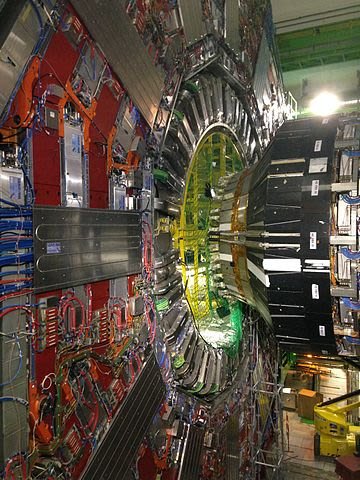
A series of detectors is arranged around the chamber where particle collisions take place, and the signals produced by a very large number of collision events are processed by very sophisticated computer programming to yield information about the particles made in the collisions. The system produces a picture of the paths that the particles take and measures the energy they carry, it also compares the results with data from known particles held in memory and so can quickly identify novel events and products. It is expected that there will be one event of interest for every 10 million background events.
MODERN PARTICLE ACCELERATORS
Modern particle accelerators are of three main kinds: linear accelerators (linacs), cyclotrons and synchrotrons.
LINEAR ACCELERATORS
In a linear accelerator, charged particles are accelerated along a straight evacuated tunnel by a set of switched anodes which produce a moving accelerating field. They are cheaper than accelerators with circular tracks because they don’t need bending magnets, and cost depends mostly on that of the coils and the special steel required for the magnets.
The most powerful linear accelerator (linac) is at Stanford Linear Accelerator Center (SLAC) in California, USA. It is 3 km long and originally fired electrons with energies of 50 GeV at fixed targets. It provided the first experimental evidence for the existence of quarks. It has been upgraded to allow opposing streams of electrons and positrons to collide at a combined energy of 10 GeV. The electrons come from a heated filament, just as in a TV set. Then they pass through a chain of 100 000 electrodes. The electrons leave one cylinder and are pulled towards the next by a comparatively small difference in voltage set up between the pair of electrodes at just the right time. The electrons are made to move close to the speed of light by very rapid voltage switching. This is done by feeding a high frequency radio signal to each electrode at just the right (but always changing) frequency to make the electrode more positive than the one before it. In effect, the electrons are surfing along this radio wave.

Inside view of the SLD. Justin Lebar, CC BY-SA 3.0
Linear accelerators (linacs) are both cheaper than circular accelerators, and much more efficient at feeding energy to electrons. This is because when charged particles are accelerated they emit radio waves and so lose energy, and when the particles move in a circular path they are always being accelerated towards the centre of the circle, even if they move at a constant speed round it.
The radiation emitted by accelerating particles is called synchrotron radiation. Since electrons have such a large charge compared to their mass, they lose a large fraction of their kinetic energy moving at high speeds in a circle. The effect is less for more massive particles such as protons.
CIRCULAR ACCELERATORS – CYCLOTRONS
In cyclotrons, a magnetic field forces charged particles to move in a circular path. The voltage on the D-shaped parts alternates so that the particles accelerate from one D to the other. The particles gain speed, so the path is actually an outward spiral. The maximum energy depends on how many times they can spiral before leaving the machine. Cyclotrons provide energetic particles for medical treatment and for the testing of advanced industrial materials.
SYNCHROTRONS
At very high energies, particles become more massive because of relativistic effects near light speed. So in a cyclotron they take longer to complete a circuit and then the alternating voltage that accelerates them fails to synchronise with them.
Synchrotrons overcome this problem: the frequency of the alternating voltage changes to match the increasing flight time of the particles. But at high energies the particles are moving at speeds so close to that of light that they actually make a circuit in a constant time: instead of getting faster, they just gain more momentum via an increase in mass. This effect underlies the design of synchrotrons.
They are very large machines. Particles are accelerated by passing through hollow anodes as in linear accelerators, but the track is circular. With a curved track, the particles can keep being accelerated without running out of track (as they eventually do in a linear accelerator) and in modern synchrotrons they keep moving in the circular path indefinitely, in storage rings. Particles are first accelerated by smaller linacs or cyclotrons, then enter the synchrotron already travelling very close to light speed. They are held in a path of constant radius by strong magnetic fields, which are made even stronger as the particles gain more kinetic energy.
Most modern discoveries about fundamental particles come from supersynchrotrons. Their radius is very large, and superconducting coils are used to activate the electromagnets. Very large currents in superconducting coils avoid the heating effects that ordinary conductors would produce.
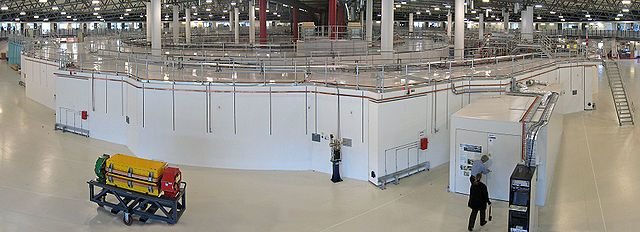
The interior of the Australian Synchrotron facility, a synchrotron light source. jjron, CC BY-SA 3.0
TARGETS AND COLLISIONS
FIXED AND MOVING TARGETS
High energies are required to investigate subatomic particles. In a collision, the ‘spare’ energy appears as a flux of particles. The larger the mass of a newly created particle, the greater the energy needed, which depends on the total accelerating voltage available.
In the late 1970s, the physicists at CERN came up with a brilliant idea. If you could fire two particles in opposite directions and make them collide, you would double the available energy at a stroke, without increasing the maximum kinetic energies of the particles. This was the principle used in the now obsolete LEP (Large Electron-Positron collider) and in the new Large Hadron Collider (LHC).
The LHC is designed to accelerate protons in opposite directions around the circular tunnel 27 km long in circumference. Each proton has an energy of 7 TeV (7 × 1012 eV), which means that it travels at 0.999 999 991 times the speed of light. The combined collision energy is thus 14 TeV, compared with 2 TeV obtained in the current highest energy system, Fermilab in Chicago, USA. Only a small fraction of the protons in the beams actually collide when the beams cross, but with such a large number of particles ten billion collisions per second are expected during the course of an experiment. Hence the need for rapid data capture and analysis.
WHAT CAN HAPPEN IN COLLISIONS AT HIGH ENERGIES
Proton-proton collisions
Hit an atom hard enough and it emits photons as the excited atom goes back to its ground state. Hit a proton (a lot harder!): it also becomes excited, and a very short time later emits pions. Unlike photons, a pion is unstable and decays very quickly, in 10-8 s, into a muon and a neutrino. The muon (a kind of giant electron) decays more slowly, in 2 × 10-6 s, into an electron and a neutrino. The Universe is surprisingly full of neutrinos – which don’t decay: about a thousand billion (1012) pass through your body every second, at the speed of light.
Proton-antiproton collisions
When protons and antiprotons collide, they annihilate each other. The energy available is therefore not just their acquired kinetic energy but also the energy due to their rest masses. The rest-mass energy is small, however, compared with the kinetic energy for particles travelling close to the speed of light – and is usually ignored.
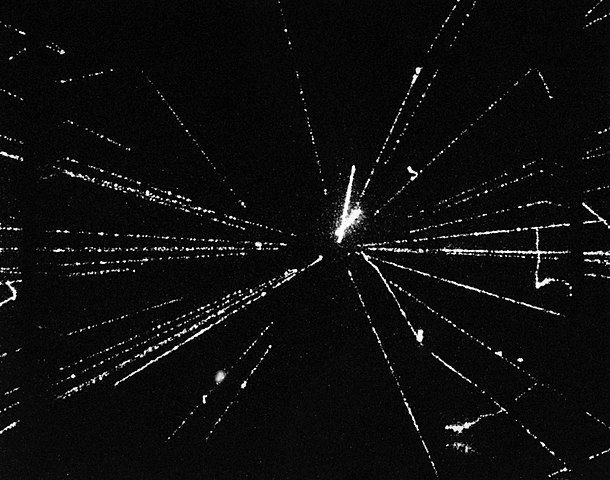
Decays
The only stable particles we meet in particle physics are the proton, electron and neutrino (and their antiparticles). When a particle decays it must obey the conservation laws, Charge, mass-energy, momentum and baryon number are always strictly conserved. Strangeness can be ‘lost’ if the weak interaction is involved.
Mass-energy
In any decay, the new particles must always have less total rest mass than the original particle that decays. Any mass-energy left over will appear as kinetic energy in the new particles.
Momentum
In simple decays, we assume that the original particle is at rest and so has zero momentum. This means that the particles must move off in the particular directions and at the particular speeds which combine to produce zero momentum.
WHY STABLE PARTICLES ARE STABLE
The stable particles are stable because there is no particle with smaller mass that they can decay into without breaking a conservation law. There is no baryon with less mass than a proton, so it is stable. It could decay into pions and still conserve energy, charge and momentum – but this would not conserve baryon number. Pions are mesons with zero baryon number and so the decay is forbidden. Similarly, electrons could decay into neutrinos but for the fact that charge has to be conserved.
REFERENCES
https://www.britannica.com/science/subatomic-particle
http://www.iop.org/resources/topic/archive/cern/index.html
https://www2.physics.ox.ac.uk/sites/default/files/Detectors.pdf
https://home.cern/science/experiments/how-detector-works
https://www.britannica.com/science/bubble-chamber
https://en.wikipedia.org/wiki/Bubble_chamber
https://www.sciencedirect.com/topics/physics-and-astronomy/spark-chambers
https://en.wikipedia.org/wiki/Spark_chamber
https://www.britannica.com/science/multiwire-proportional-chamber
https://en.wikipedia.org/wiki/Wire_chamber
https://home.cern/science/accelerators/large-hadron-collider
https://en.wikipedia.org/wiki/Large_Electron%E2%80%93Positron_Collider
https://home.cern/science/accelerators/large-electron-positron-collider
https://www.britannica.com/technology/particle-accelerator
https://en.wikipedia.org/wiki/List_of_accelerators_in_particle_physics
This post has been voted on by the SteemSTEM curation team and voting trail. It is elligible for support from @curie and @minnowbooster.
If you appreciate the work we are doing, then consider supporting our witness @stem.witness. Additional witness support to the curie witness would be appreciated as well.
For additional information please join us on the SteemSTEM discord and to get to know the rest of the community!
Thanks for having used the steemstem.io app and included @steemstem in the list of beneficiaries of this post. This granted you a stronger support from SteemSTEM.
How come I wasn't following you? :D
Take care and keep posting, even if I am a little late to read it...